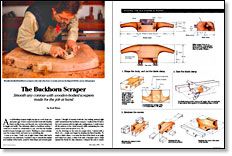The Buckhorn Scraper
Smooth any contour with wooden-bodied scrapers made for the job at hand
Synopsis: Architect, designer, and furniture builder Scott Wynn says a wooden-bodied buckhorn scrapers takes only a few hours to make and can be shaped to fit the curves of any project. It has handles flared out like horns and the sole is curved along both its length and width. To make one, Wynn starts with a block of 8/4 maple and uses a bandsaw, handsaw, and chisel to get it to its finished shape. Numerous drawings clarify each step, from shaping the body and cutting the blade clamp to fitting the blade seat and shaping the sole.
An odd-looking scraper caught my eye at a tool swap several years ago. It had a round wooden body with handles flared out like horns, and the sole was curved along both its length and width. The old-timers called it a buckhorn scraper. I could see it would be comfortable to use, and that the handles would increase leverage and control. Thinking it a mere curiosity, I put the scraper down and went on to something else.
A year or so later, I built a set of eight cherry chairs with backs coopered in two directions. I needed a way to smooth the insides and outsides of the backs, preserve their shape and prevent grain tearout. I thought of several methods, but nothing seemed right until I remembered the buckhorn scraper. I realized that if I had a few such scrapers with the right sole configurations, I could scrape all the surfaces of the chairs smooth while maintaining the compound curves (see the photo on p. 54).
As the drawings on the next two pages show, I started with a block of maple and began by shaping the flared handles. To create a blade clamp, I cut away the front of the block at an angle and bolted it in place. A little work with a handsaw and a chisel opened the throat for chip clearance. I shaped the sole to match the work and shaped the blade to the sole. In a short time, I had a comfortable finishing tool.
Shaping the blade–I get my scraper blades from a variety of sources. I’ve used blades from my cabinet scrapers, bought new or used blades at tool swaps and made blades from old handsaws. A blade will often work in several other scrapers depending on the configuration of the sole. If the scrapers are curved only along their length, a straight-edged blade will work in all of them. Scrapers with the same radius curve across their width also can share blades. Because scraper blades have two useable sides, one blade can have two different profiles, further reducing the number of blades I need.
To give a blade the correct curve, I simply install it in the completed scraper so it’s just barely exposed through the mouth. I mark the curve and remove the blade. When sharpened, the blade will be honed at a bevel, but when I’m shaping the blade, I grind the edge square down to the line. I check my progress frequently by reinserting the blade and sighting down the sole.
From Fine Woodworking #118
For the full article, download the PDF below:
Fine Woodworking Recommended Products

Veritas Micro-Adjust Wheel Marking Gauge

Tite-Mark Marking Gauge

Lie-Nielsen No. 102 Low Angle Block Plane




















Log in or create an account to post a comment.
Sign up Log in